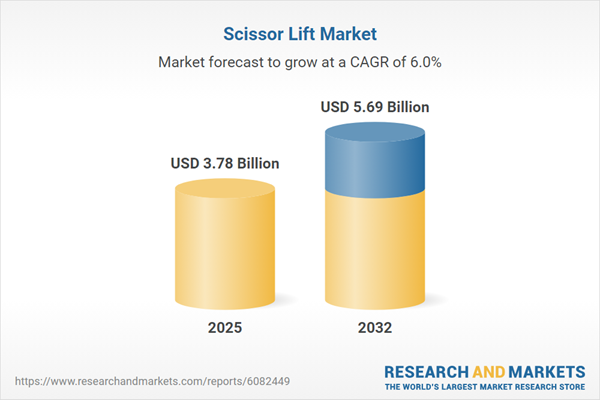Speak directly to the analyst to clarify any post sales queries you may have.
The scissor lift market is experiencing a dynamic transformation, driven by innovation, digitalization, and the evolving operational needs of end users in construction, manufacturing, warehousing, and infrastructure sectors.
Market Snapshot: Scissor Lift Market Outlook
The global scissor lift market grew from USD 3.56 billion in 2024 to USD 3.78 billion in 2025 and is expected to continue expanding at a CAGR of 6.01%, reaching USD 5.69 billion by 2032. Growth in this market is propelled by safety-focused regulations, technology integration, and the increasing demand for efficient aerial work platforms across diverse industries.
Scope & Segmentation: Comprehensive Market Coverage
- Platform Types: Mobile (including self-propelled and towable units) and stationary platforms address varied mobility and operational requirements, supporting both indoor and outdoor deployment.
- Power Sources: Diesel, electric, and hybrid systems enable operation in remote, heavy-duty, or urban settings, each catering to unique efficiency and sustainability goals.
- End User Industries: Construction (commercial, infrastructure, residential), manufacturing, oil & gas, utilities & telecom, along with warehousing & logistics illustrate the broadening scope of scissor lift applications.
- Platform Heights: Up to 10 feet, 10 to 26 feet, and greater than 26 feet categories align with distinct site layout and safety needs.
- Load Capacities: Up to 500 kilograms, 500 to 1000 kilograms, and above 1000 kilograms provide flexibility for projects ranging from light maintenance to heavy industrial tasks.
- Regional Coverage: Americas (North America, Latin America), Europe, Middle East & Africa (divided into Europe, Middle East, Africa), and Asia-Pacific, including major economies such as the United States, China, India, and Germany.
- Key Players: The competitive landscape features Oshkosh Corporation, Terex Corporation, Linamar Corporation, Haulotte Group, XCMG Construction Machinery Co., Ltd., Zoomlion Heavy Industry Science & Technology Co., Ltd., MEC Aerial Work Platforms, LLC, Sinoboom Group Co., Ltd., Zhejiang Dingli Machinery Co., Ltd., and Shandong LGMG Intelligent Equipment Co., Ltd.
Key Takeaways for Senior Decision-Makers
- Technological upgrades, such as control systems and advanced telematics, are redefining fleet management, driving operational efficiency and uptime optimization across user segments.
- The adoption of intelligent features and semi-autonomous navigation is reducing manual labor dependency and enhancing productivity in construction, warehousing, and telecom operations.
- Flexible rental and leasing service models, incorporating usage-based pricing and maintenance, support varied stakeholder needs and foster recurring revenue streams for providers.
- Sustainability is emerging as a critical business imperative, with a notable shift to electric and hybrid platforms and the integration of renewable energy infrastructure across fleets.
- Strategic collaborations and M&A activities are expanding market reach and strengthening competitiveness, particularly through value-added service expansion and geographic coverage.
- Regionally, evolving regulations, industry modernization, and investment in infrastructure upgrades create unique growth avenues, requiring tailored go-to-market strategies.
Tariff Impact: Strategic Industry Adjustments in 2025
Recent tariff increases in 2025 have resulted in higher procurement costs for imported hydraulic, electronic, and steel components, prompting manufacturers to adjust sourcing strategies. Near-shoring and regional supply partnerships are instrumental in reducing exposure to trade risks, while product redesigns help offset increased material costs without compromising unit performance or safety standards.
Methodology & Data Sources
The market analysis is underpinned by over fifty executive interviews, on-site visits, and workshops, supplemented by secondary sources such as industry publications, patent databases, and regulatory filings. Rigorous data validation protocols and triangulated feedback loops ensure the reliability and accuracy of all presented insights.
Scissor Lift Market: Why This Report Matters
- It provides actionable recommendations and tailored segmentation analysis for senior leaders building robust, future-proof go-to-market and development strategies.
- In-depth regional context and technology adoption trends reveal where the most promising growth and investment opportunities are emerging worldwide.
- The report enables organizations to benchmark against leading OEMs, adapt to rapid regulatory shifts, and strengthen supply chain resilience for sustained advantage.
Conclusion
The scissor lift market is characterized by dynamic innovation, agile business models, and an increasing focus on sustainability and end-user safety. Strategic adaptation to shifting regulations, technology trends, and regional dynamics will be key to securing and maintaining competitive leadership in this evolving sector.
Table of Contents
3. Executive Summary
4. Market Overview
7. Cumulative Impact of Artificial Intelligence 2025
List of Figures
Samples

LOADING...
Companies Mentioned
The key companies profiled in this Scissor Lift market report include:- Oshkosh Corporation
- Terex Corporation
- Linamar Corporation
- Haulotte Group
- XCMG Construction Machinery Co., Ltd.
- Zoomlion Heavy Industry Science & Technology Co., Ltd.
- MEC Aerial Work Platforms, LLC
- Sinoboom Group Co., Ltd.
- Zhejiang Dingli Machinery Co., Ltd.
- Shandong LGMG Intelligent Equipment Co., Ltd.
Table Information
| Report Attribute | Details |
|---|---|
| No. of Pages | 197 |
| Published | October 2025 |
| Forecast Period | 2025 - 2032 |
| Estimated Market Value ( USD | $ 3.78 Billion |
| Forecasted Market Value ( USD | $ 5.69 Billion |
| Compound Annual Growth Rate | 6.0% |
| Regions Covered | Global |
| No. of Companies Mentioned | 11 |









